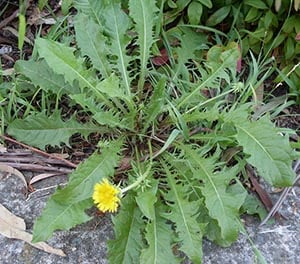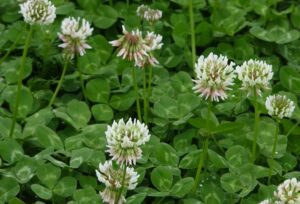by Kristen Colburn
I recently had the pleasure of attending an edible and medicinal plant walk with the director of my local environmental education center. It was an enjoyable and educational experience that allowed me to learn about a number of different plants in my community and the unique uses that many of them have. I thought I’d share some of the information I learned so that others may become more informed, as well.
Please note: the information and other content provided in this blog, website or in any linked materials are not intended and should not be considered, or used as a substitute for, medical advice, diagnosis or treatment. Always seek the advice of your physician or other qualified health care provider with any questions you may have regarding a medical condition or treatment.
 Name: Plantain Weed
Name: Plantain Weed
Location: All over North America in pastures, fields, gardens, footpaths, along roadsides, and in your lawn. It thrives in direct sunlight but can also withstand partial shade.
Distinguishing features: Oval-shaped medium leaves with prominent parallel veins that run vertically from stem to tip. Leaves grow low to the ground in a basal rosette, meaning they grow at the base of the plant and overlap to loosely form a rose-like shape.
Medicinal uses:
- Fun fact: it’s often called “the Band-aid plant” because of its antiseptic, antimicrobial, and anti-inflammatory properties.
- If you’re suffering from a bug bite, bee sting, or contact with poison ivy, you can make a poultice with Plantain to take away the sting and itch. Simply chew on a plantain leaf until it becomes pulpy, apply the pulp to the wound and let it sit until soothed. This method is also useful for bringing splinters to the surface of the skin for removal.
- Plantain herbal infusion. Chop plantain leaves finely, place in a canning or glass jar, and fill the jar with Extra Virgin Olive Oil. Cap the jar and leave near a sunny window for 3-8 weeks. When ready to use, press out the oil using a strainer or cheese cloth into a separate jar. [1] This oil can be used in lotions and soaps, or can be applied topically to cats and dogs to treat minor skin irritations.
Edible uses:
- It can be eaten raw or cooked and used fresh or dried. It’s a great source of calcium, zinc, beta-carotene, and chlorophyll. The leaves are more tender in the spring and can be used in salads, as a garnish, or blended into smoothies.
- As the leaves get tougher later in the year, they can be wilted for use as a side dish or in stir-fries. Many people harvest and dry the leaves during the summer so that in the winter they can crumble the leaves into soups.
 Name: Lemon balm
Name: Lemon balm
Location: All over North America. Can be grown in gardens. Plants grown in partial shade will be larger and more succulent than those grown in full sun.
Distinguishing features: Heart-shaped leaves that are smooth or hairy/wooly with teeth or lobed-shaped edges. Square roots. If you rub the leaves between your fingers, it smells tart and sweet, like lemons. Fun fact: lemon balm is part of the mint family, and mint plants can be recognized by their square roots.
Medicinal uses:
- Lemon balm is a powerful antiviral that has been proven to fight and prevent cold sores. Steep crushed lemon balm leaves in a cup of boiling water for 10-15 minutes, cool, and apply with a cotton ball to cold sores throughout the day. You can also make your own cold sore lip balm.
- Also known for its relaxing qualities, lemon balm can be made into an herbal syrup to help promote sleep. Place 3/4 cup of lemon balm leaves into a small pot and add enough water just to cover the leaves. Bring to a simmer, partially covered, until the liquid has reduced by half. Strain out the leaves and, while the liquid is still warm, place 1/2 cup into a jar. Add 1/4 cup of raw honey to the liquid and stir. Store the syrup in the refrigerator for ~3 days and take a spoonful each night to help calm and relax. [2] Remember: honey should not be given to children under 1 year old.
Edible uses:
- Finely chop a pinch of lemon balm leaves and add to 4 tablespoons of softened butter. Add a touch of honey to taste. This creates a delicious lemon balm and honey butter for use on fresh bread or biscuits.
- Lemon balm water is refreshing on a hot summer day. Simply fill a jar with lemon balm leaves, add a thinly sliced lemon, and fill with cold water. Refrigerate for several hours.
- Lemon balm is most commonly used in tea – remove leaves and rinse well, dry them on a baking sheet or other flat surface, then (when dry) add to boiling water and steep for about 5 minutes.
 Name: Dandelion
Name: Dandelion
Location: Throughout all of the U.S., in lawns, orchards, hay fields, pastures, and roadsides.
Distinguishing features: Smooth, hollow stem. Leaves are smooth-margined, deeply cut, or toothed. Like the plantain weed, dandelion have basal leaves, so they grow low to the ground and from the bottom of the stem only. Dandelion flowers produce yellow blooms that are disk shaped.
Medicinal uses:
- Fun fact: dandelion is richer in calcium than spinach! When eaten (raw or cooked), dandelion is an excellent source of vitamins A, C, and K. Dandelion greens contain minerals such as iron, calcium, magnesium, and potassium. They also contain high levels of beta carotene, which converts to vitamin A in the body and can be beneficial for a strong immune system and healthy eyes, skin, and even mucous membranes. [3]
- You can create a strong tincture that can be added by the dropperful to a glass of water to use as a health tonic. Gather a cup or two of dandelion roots, clean them, and slice them thinly. Add them to a mason jar, cover with 100 proof vodka, cover, and let it sit in a cool, dark place for 8 weeks. [4] You can add some honey to the mixture to help improve taste.
- Dandelion lotion bars can help heal tough cases of cracked and dry skin. Jan Berry shows you how here.
Edible uses:
- Mature dandelions taste similar to arugula or kale and can have a bitter flavor. You can boil or sauté dandelions to reduce the bitterness. Sautéed dandelions are often used as a side dish or as an additive to soups.
- Dandelion tea can be made by packing fresh flowers and leaves into a mason jar and covering with simmering water. Allow the tea to infuse by letting it sit until cool, then strain out the flowers.
- Young dandelion flowers often taste sweet, similar to honey. For this reason, they are often used in recipes for pancakes, muffins, cookies, and even wine!
Name: Clover
Location: Throughout all of the U.S., though it’s mainly concentrated in the cooler, northern and midwestern regions. It can be found in grasslands and lawns.
Distinguishing features: There are two types of clover – white and red. White clover stay at ground level, while red clover can grow as high as 2 feet tall. White clover will have clusters of white flowers, while red clover will have flowers with a pinkish-purple hue. Clover has small, tear drop or petal shaped leaves. Each stem has three leaflets. Many have a white “v” on each leaf.
Medicinal uses:
- Clover contains vitamins A, B2, B3, C, and E as well as magnesium, potassium, chromium, and calcium. The leaves are packed with protein and macronutrients. [5] These leaves can be used to create a poultice to help alleviate burns, bites, and stings, just like the plantain weed.
- As with dandelion, you can make a tincture out of red clover to boost immune function. Add 3-4 cups of red clover blossoms (cleaned) to a mason jar and cover with 2 cups of vodka. Leave in a cool, dark place and shake the jar every few days. The color will begin to drain from the flowers as the tincture evolves. After one month, drain the tincture through cheesecloth, making sure to squeeze all of the liquid from the flowers. Save the tincture solution in a glass jar and add 1/2 dropper to a cup of tea or water whenever you’re feeling ill or have been exposed to a lot of germs. [6]
Edible uses:
- Leaves can be eaten raw in salads or used as a garnish, though the leaves do taste best when cooked. You can sauté them as you would spinach. Make sure to thoroughly clean the leaves before consuming.
- Dried leaves and flowers can be used in baked goods and have been said to have a mild, vanilla-like flavor. Check out this red clover biscuits recipe.
 Name: Queen Anne’s Lace
Name: Queen Anne’s Lace
Location: Naturalized throughout much of the U.S. Found in disturbed areas like roadsides, trails, backyards, and vacant fields.
Distinguishing features: Coarse and hairy stem with wispy leaves and a pad of white flowers that grow in the summer. Fun fact: Queen Anne’s Lace belongs to the carrot family and is often called “wild carrot.” If you break the stem in half, it smells just like a carrot.
Warnings:
- Queen Anne’s Lace works as an implantation inhibitor and should be avoided by those who are pregnant. [7]
- Poison Hemlock is often confused with Queen Anne’s Lace. Queen Anne’s Lace has a hairy stem and doesn’t grow much taller than 3 feet. Poison Hemlock has a smooth stem and can grow up to 10 feet tall. (Find more identification tips here)
Medicinal uses:
- An essential oil from the seed has been used in anti-aging creams [8], insecticides have been created from a decoction of the seed and root, and infusions have been used to help treat digestive disorders and kidney and bladder diseases. However, there are limited resources available for individuals to be able to make their own Queen Anne’s Lace medicinal products at home.
Edible uses:
- Queen Anne’s Lace jelly is an interesting and tasty way to enjoy this plant.
- The flowers can be easily fried. Combine flour, sea salt, and cayenne pepper in a bowl. To another bowl add some whisked eggs. Dip the flowers in the egg and then in the flour mixture. Heat an inch of oil in a skillet and, when sizzling, add the battered flowers. Fry upside down (stem side up) for 30 seconds to 1 minute. Enjoy while warm. [9]
- A Queen Anne’s Lace cordial can be enjoyed with or without alcohol. For a non-alcoholic cordial, simply bring water to a boil and remove from heat. Add 30 large Queen Anne’s Lace flower heads (push them into the water), cover, let steep for 30-60 minutes (or overnight), and strain. Add 3 1/2 cups of sugar and 1/4 cup lemon juice, stir, and enjoy. [10]
References
[1] Shutes, J. (n.d.). Spring Plantain Herbal Infusion. Retrieved from: https://aromaticstudies.com/spring-plantain-herbal-infusion/
[2] Barry, J. (n.d.). 12+ Things to Do With Lemon Balm. Retrieved from: https://thenerdyfarmwife.com/12-things-to-do-with-lemon-balm/
[3] Link, R. (2022, January 4). 13 Emerging Health Benefits of Dandelion. Retrieved from: https://www.healthline.com/nutrition/dandelion-benefits
[4] Jaques, L. (2017, April 8). Fun With Dandelions: Food and Medicine. Retrieved from: https://gardenerspath.com/plants/herbs/fun-with-dandelions/
[5] Wong, C. (2022, October 19). What Is Red Clover? Retrieved from: https://www.verywellhealth.com/the-benefits-of-red-clover-89577
[6] Keller, Z. (n.d.). Red Clover Tincture. Retrieved from: https://onebeetwellness.com/red-clover-tincture/
[7] Dutton-Kenny, M. (2020, February 21). Using Queen Anne’s Lace to Manage Fertility. Retrieved from: http://www.mollyduttonkenny.com/blog-mdk/using-queen-annes-lace-for-managing-fertility
[8] Jarnot, J. (2015, March 15). Carrot Seed Oil. Retrieved from: https://www.beauty-heroes.com/blog/carrot-seed-oil/
[9] Foraging Series: Part 2 – Queen Anne’s Lace. (2013, July 20). The Crunchy Delinquent. Retrieved from: https://thecrunchydelinquent.wordpress.com/2013/07/10/foraging-series-part-2-queen-annes-lace/
[10] The Marvels of Queen Anne’s Lace. (n.d.). Mom Prepares. Retrieved from: https://momprepares.com/the-marvels-of-queen-annes-lace/


